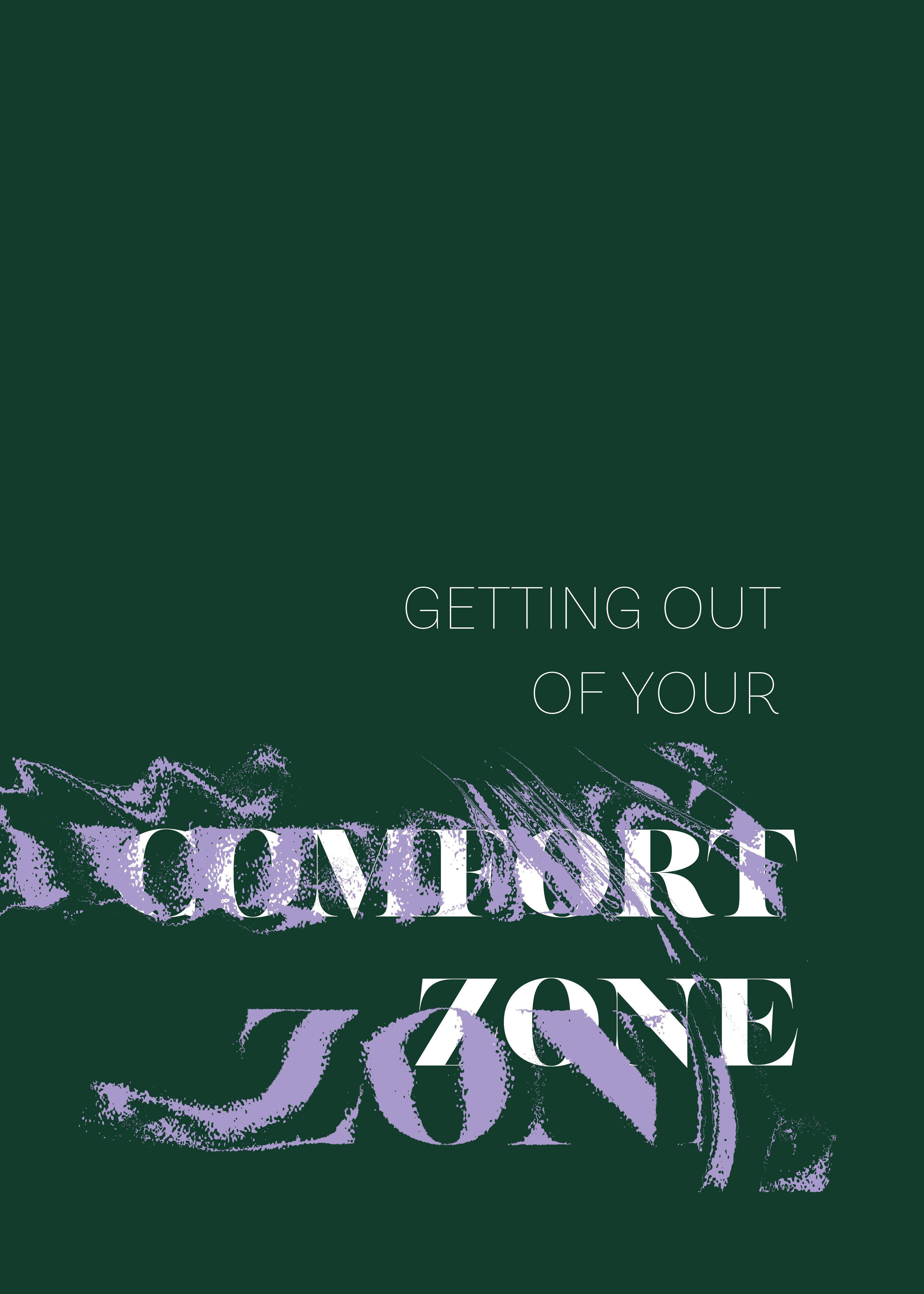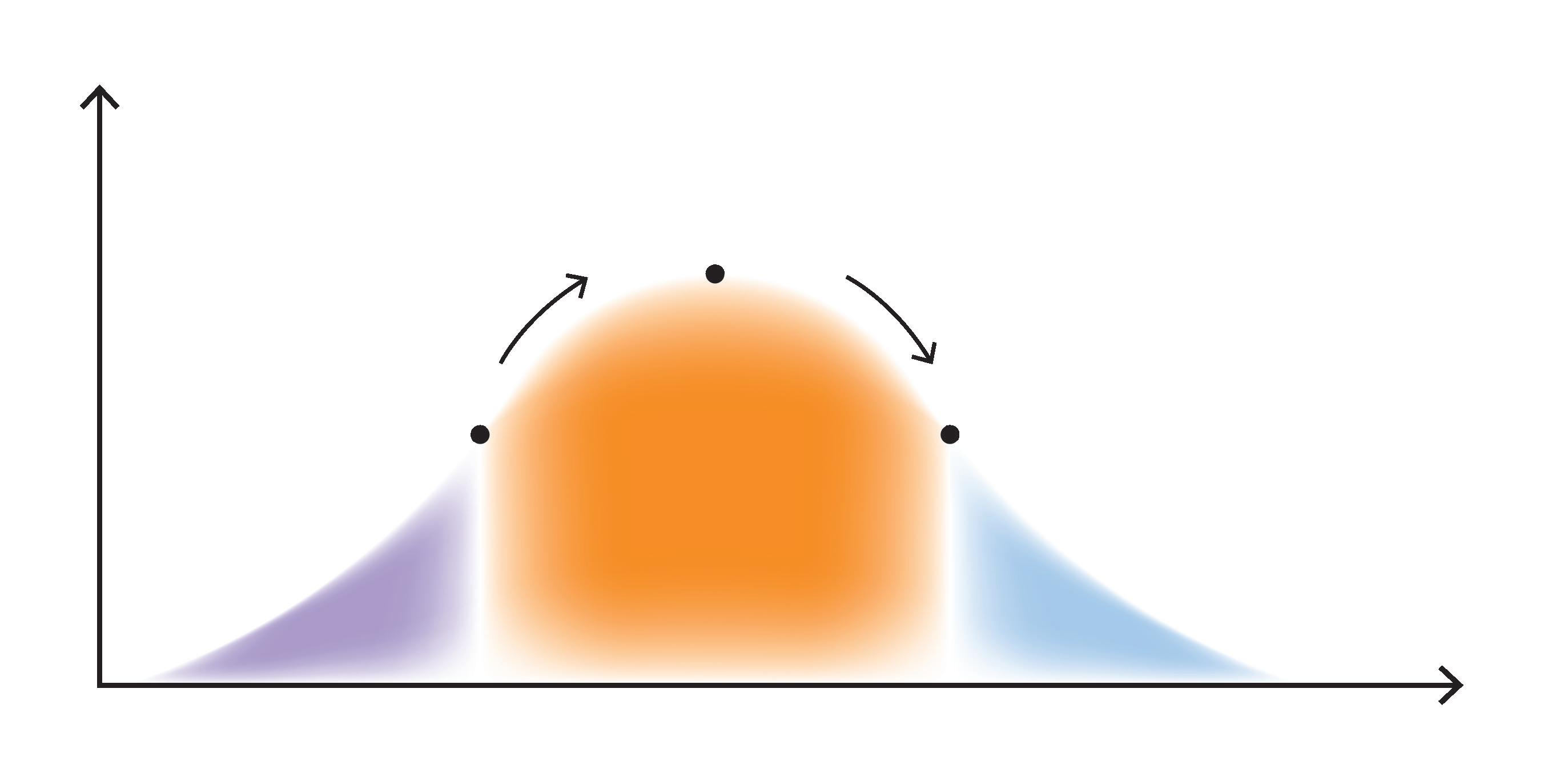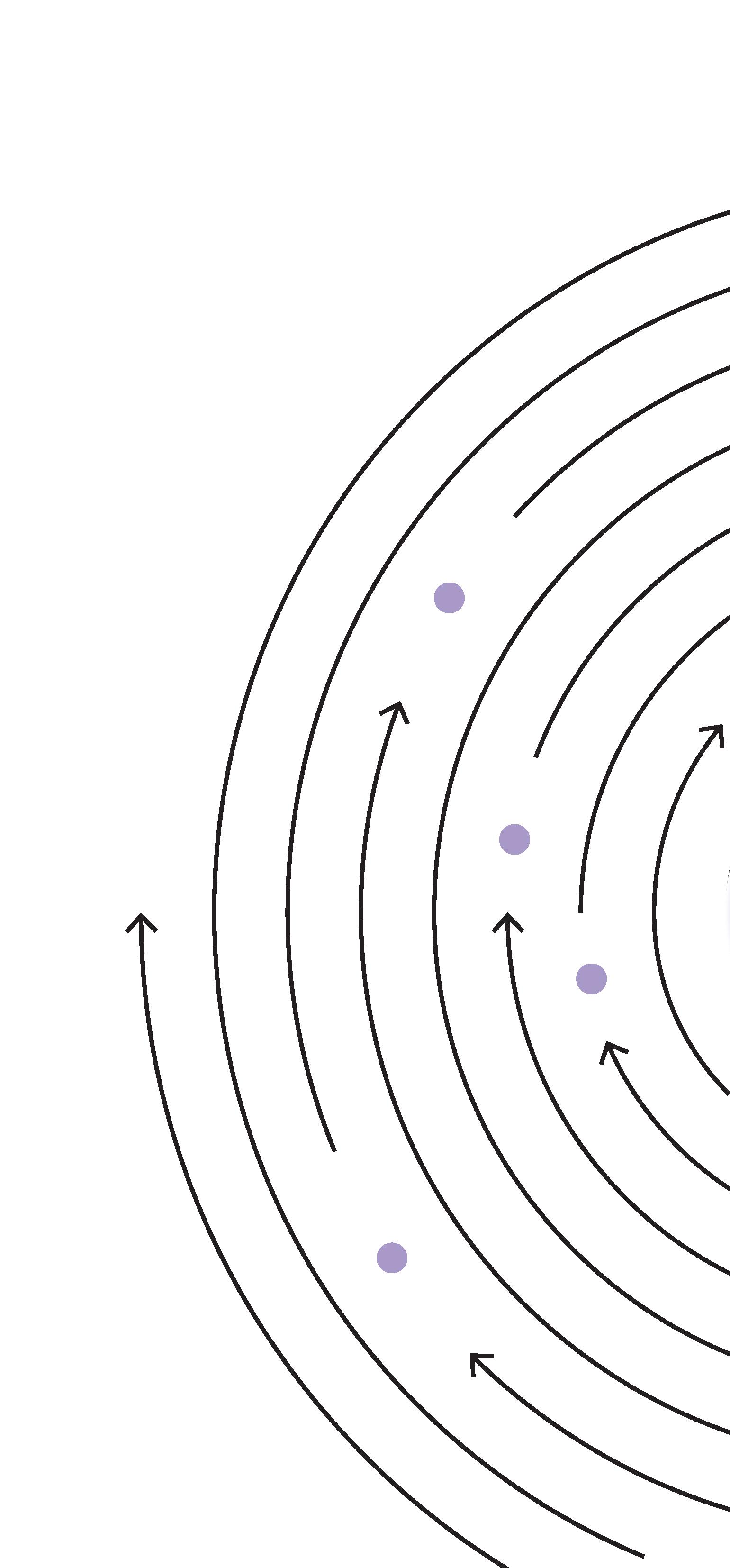
What is comfort zone and how it affects our life
Tips to support leaving your comfort zone
How do comfort zones develop

12
4 5
13
Conclusion
From comfort zone to the growth zone
Benefits of leaving the comfort zone: 4 examples
4 Ways to build self-efficacy
The pros of staying in your comfort zone
The cons of staying in your comfort zone

6 7 9 10
11
WHAT IS COMFORT ZONE AND HOW IT AFFECTS OUR LIFE?
THE COMFORT ZONE IN PSYCHOLOGY
The metaphor of "leaving one's comfort zone," which is now firmly established in cultural discourse, gained popularity in the 1990s. Judith Bardwick, a management theorist, created the term "comfort zone" in her 1991 book Danger in the Comfort Zone:
“The comfort zone is a behavioral state within which a person operates in an anxiety-neutral condition, using a limited set of behaviors to deliver a steady level of performance, usually without a sense of risk.”
What a beautiful way to describe a wonderful state of being is using the word "comfort." We all seek solace since it's in our nature to do so. You would think that our pursuit of comfort would be a noble endeavor, but in truth, it is one of humanity's biggest inherent growth inhibitors. Comfort zones affect our well-being and ability to reach our full potential in positive and negative ways. They do act as a "safe haven" for us when the pressures of the outside world become too much to bear, but they may also serve as a siren song that lulls us into sloth.
Think about the distinction between giving a presentation versus listening to one, for instance.While watching the presentation is entirely inside our comfort zone, actually giving it pushes us out of it by instilling doubt and worry. Intuitively, we know that a strong presentation can launch our career, but the fear of messing up and showing our vulnerability creates a strong barrier that frequently forces us to retreat to our safe haven. Even worse, by letting fear control our decisions, we weaken our self-confidence and reinforce our self-limiting belief that we are powerless to overcome these restrictions.
Within the comfort zone, there isn’t much incentive for people to reach new heights of performance. It’s here that people go about routines devoid of risk, causing their progress to plateau.
But the world of behavioral psychology is where the idea first emerged. One of the earliest studies that revealed a connection between anxiety and performance was carried out in 1907 by Robert Yerkes and John Dodson.
They observed that, up to a point, electric shocks of increasing strength increased the motivation of mice to finish mazes. They stopped performing after they reached a certain point and started to hide.
In humans, same behavior has been observed. This makes sense given that the three alternatives for dealing with anxiety-inducing stimuli are fight (face the challenge), flight (run away/hide), or freeze (become paralyzed).
The Yerkes-Dodson Law (Yerkes & Dodson, 1907) holds true in many facets of life, including self-awareness, interpersonal relationships, and other more intangible aspects of performance, such as receiving a challenging new task at work.
Our neural systems have a Goldilocks zone of arousal, which is the central tenet. If you do too little, boredom will eventually set in as you stay in your comfort zone. However, too much can cause you to reach the “panic” zone, which also slows down movement:
4
HOW DO COMFORT ZONES DEVELOP?

The chains of habit are too light to be felt until they are too heavy to be broken, according to English philosopher Bertrand Russell. Research on habits has shown that they typically form subconsciously, with the habit holder frequently unaware of their very existence. While some of our ingrained habits and patterns of behavior are intended to benefit and support us, others may be less virtuous.
We frequently form habits that restrict us from doing things that would put us in danger or expose us to things we could perceive as harmful since the human mind evolved to keep us safe from harm. This is helpful when confronting a predator or navigating unfamiliar territory, but it is less helpful when the perceived risk involves public speaking, taking responsibility of a crisis with your team, or accepting a job offer that would put our skills to the fullest test.
Our "comfort zone" is created by these regular and routine behaviors. As a result of all of our conditioned behaviors and the ongoing thought patterns we engage in every day of our lives, a safe metaphorical
environment where we feel secure and at peace gradually emerges in our minds. It's a place where we can work at a somewhat steady and comfortable pace without interruption, risk, or harm to our sense of safety.
Our comfort zone doesn't always work for us in every situation, especially in the current world where such perceived risks are more concerned with psychological or egological harm than with physical harm. It is sometimes accountable for preventing us from reaching our full potential. What we consider to be "comfortable" might actually become a location of stagnation and reduction, one that prevents us from taking advantage of growth possibilities because they might include something strange or something we think would expose us.
The good news is that you are not your habits, and by making conscious efforts and using intentional thought, you can stretch and control your comfort zone.
5
boredom panic anxiety
optimal level
pereformance
increase in attention decrease in performance
FROM COMFORT ZONE TO THE GROWTH ZONE
GROWTH ZONE
LEARNING ZONE
FEAR ZONE
Gain control & find purpose
Acquire new skills
Lacking self - confidence
Safe & in control
Fear doesn't always correlate to being in the panic zone when one is leaving one's comfort zone. Fear can be an essential step on the way to the learning and growth zones, as the graphic above illustrates.
To leave your comfort zone and enter the fear zone requires guts. It is impossible to improve upon prior experiences without a clear route map. This might make you feel anxious. But if you persist long enough, you'll enter the learning zone, where you'll pick up new abilities and find creative solutions to problems.

A new comfort zone is developed after a learning phase, increasing one's capacity to achieve even greater heights. This is what it means to be in the growth zone.
It's vital to note that, similar to other attempts at behavioral modification, entering the growth zone is more difficult without some degree of selfawareness. As a result, it may be advantageous for you to think about the following >>
6
COMFORT ZONE
− WHAT IS THE SIZE OF YOUR ZONES?

Everybody’s zones are different sizes across every life sector. You must recognize the limitations of your comfort zone before stepping outside of it. Similar to this, you need to learn to intuitively recognize where your panic zone is. You will stretch yourself by taking on problems that fall halfway in between, which will result in growth and learning.
− WHAT ARE YOUR STRENGTHS?
Recognizing and utilizing one’s strengths can be very beneficial. Most people have had the experience of stepping outside of their comfort zone in at least one aspect of their lives, and there are frequently many lessons to be learned from this experience.
in practice, the transition from a comfort zone to a growth zone can not be straightforward. Peaks, valleys, and plateaus
can make the journey more challenging. In other cases, we may need to occasionally withdraw to our familiar surroundings before gathering the fortitude to venture out again. Even so, accepting the process might make uncertainty easier to bear. It’s alluring to feel secure, in charge, and that things are going smoothly when one is in their comfort zone. It goes without a hitch.
4BENEFITS OF LEAVING THE COMFORT ZONE: EXAMPLES
Leaving your comfort zone has several less obvious advantages besides improving performance. Here are four top-line, broadly applicable examples rather than a complete list that would demand a separate article.
1. SELF-ACTUALIZATION
Self-actualization is a significant motivator for many people to step outside their comfort zone. The theory of human motivation developed by Abraham Maslow in 1943, which he summarized as follows: “What a man can be, he must be. This need we may call self-actualization.”
Our basic and psychological requirements are satisfied when we are in our comfort zone, according to Maslow's hierarchy of needs, which works like a ladder. The notion asserts that whether we are aware of it or not, our next need is for personal fulfillment and growth.
This change is comparable to trying to achieve self-actualization as long as the choice to leave one’s comfort zone is in line with one’s values. Why is this crucial? One reason is that failing to grow could result in stagnation later in life.
Self-fulfillment needs
psychological needs basic needs
7
SELFACTUALIZATION achieving one’s
potential, including creative activities
ESTEEM
prestige and feeling of accompishment
AND LOVE
intimate relationships, friends SAFETY
security, safety
food, water, warmth, rest
full
SELF
NEEDS
BELONGIGNESS
NEEDS
NEEDS
PHYSIOLOGICAL NEEEDS
The best sailors, however, aren’t born in smooth waters.
2. DEVELOPING A GROWTH MENTALITY
The study of mindsets by Stanford psychologist Carol Dweck in 2008 resulted in a paradigm shift in the discipline of positive psychology. Her research differentiated between the fixed and growth mindsets, two opposing belief systems.
People who have a fixed mindset think they only have a certain amount of each talent and that there is a limit to how much they can do. Failure reveals one’s shortcomings, and criticism kills one’s self-esteem. Adopting a growth mindset entails seeing people as flexible. From this perspective, failures are seen as learning opportunities and our potential is unbounded. (Dweck, 1999)
The development of a growth mindset goes hand in hand with purposefully stepping outside of your comfort zone. The development mindset broadens the realm of possibility, while the fixed mindset limits us by our fear of failure. It encourages us to learn and take reasonable chances, which has a good impact on many facets of our lives.
3. RESILIENCE AND ANTIFRAGILITY

Perhaps since life isn't exactly a predictable affair, neither should people. Everyone has to deal with difficulty at some point. People who have the habit of pushing their comfort zones are more capable of dealing with change and ambiguity, which results in resilience.
Statistician Nassim Taleb (2012) expanded on this idea by introducing the idea of "antifragile" systems, such as the immune system, evolution, and the human brain, which "thrive and grow when exposed to volatility, randomness, disorder, and stressors." Antifragile systems learn to grow from shocks and reach new heights, whereas resilient systems recover to their previous level after a shock. So long as we don't drift into the panic zone, intentionally cultivating antifragility entails stepping outside of our comfort zone.
4. GREATER SELF-EFFICACY
Albert Bandura (1997) defined self-efficacy as the conviction that one can carry out necessary actions in support of a goal. Goals that increase self-efficacy are specific, manageable, and time-bound (Yailagh, Lloyd, & Walsh, 2009).
Leaving your comfort zone entails a period of trial and error, during which success is likely to occur to some extent. When we succeed, our self-efficacy increases and our confidence in our abilities begins to increase.
This probably won’t happen overnight, like other advantages of stepping outside of your comfort zone. However, everyone canbenefit from the cumulative upward spiral of success and confidence, which can become a powerful advantage.
WAYS TO BUILD SELF-EFFICACY
8
(ACCORDING
TO ALBERT BANDURA)
4
1. MASTERY
EXPERIENCES

According to Bandura (2008), mastery experiences are the most efficient approach to increase self-efficacy.
There is no better way to begin believing in one's capacity for success than to set a goal, persevere through obstacles in the way of goalaccomplishment, and then take pleasure in the rewarding outcomes. The belief in one's ability to succeed will increase as a result of repeated exposure to the idea that persistent work and overcoming hardship will ultimately be fruitful.
Contrarily, if people consistently experience easy success with little effort, they may come to expect quick results and become easily discouraged by failure (Bandura, 2008).
When we think about parenting and early developmental events, the significance of mastery experiences becomes acute. There is a tremendous pull as a parent to shield your child from failure altogether (this is frequently referred to as "snowplow parenting").
However, a child will pass up chances to increase their self-efficacy if they don't learn how to deal with disappointment and use their inner resources to overcome challenges. As a result, the kid might not be adequately prepared to handle the obstacles they would face as adults.
Failure experiences are crucial for developing resilience. This is accomplished by viewing each setback as an opportunity for growth and a chance to become competent using a different strategy.
2. SOCIAL MODELING
Observing others who are similar to you show competence is another technique to increase self-efficacy (Bandura, 2008). In this case, the individual watching the demonstration of ability sees elements of themselves in the actor. In other words, the observer and the actor might share the same age, race, ethnicity, sexual orientation, or gender (Bandura, 1997).
The observer will be motivated to think that they can accomplish their goals after seeing the actor succeed through perseverance.
We may start to comprehend the significance of diverse representation in the media when we take into account the role models that can be used to boost self-belief. In the past, one would have had to look outside of their immediate social circle for a role model. Nowadays, people (especially young people) have access to a wide range of prospective role models thanks to the internet and other digital platforms.
They are denied the chance to develop self-efficacy through this vicarious modeling and may be less likely than other populations to pursue their goals. If these viewers never see anyone similar to themselves displaying acts of competence across the various spheres of life (for example, speaking in the media, competing in elite sports), they are denied the opportunity to develop self-efficacy.
3. SOCIAL PERSUASION
A person is more likely to succed when they hear that they have what it takes to succed. Self-efficacy therefore becomes a self-fulfilling prophecy in this manner (Eden & Zuk 1995).
While not as effective as mastery for boosting self-efficacy (Bandura, 2008), hearing from someone we can trust that we have the skills to accomplish our goals will be more empowering for us than focusing on our shortcomings.
As a result, a competent mentor can increase self-efficacy by serving as a trusted source of motivation in addition to serving as a role model. Additionally, they could encourage their mentee to enter the fray by assisting them in identifying situations where they can show their abilities without feeling overwhelmed.
Also other studies (not just Bandura's) have looked into how self-talk can boost self-efficacy and boost performance. In one study, for instance, it was discovered that tennis players who gave themselves a pep talk before practicing a particular swing outperformed a group of players who did not (Hatzigeorgiadis, Zourbanos, Goltsios, & Theodorakis, 2008).
This conclusion shows that we can verbally convince ourselves that we are capable of doing something in order to increase our self-efficacy.
4. STATES OF PHYSIOLOGY
Finally, how we assess our self-efficacy is influenced by our feelings, moods, and physical well-being (Kavanagh & Bower, 1985).
Bandura (2008) asserts that when we are fatigued and depressed, it is more difficult to feel confident in our capacity to accomplish. This is particularly true if we believe that these mental and physical states are a sign of our weakness, vulnerability, or incapacity to complete a task.
Indeed, studies have shown that although those with depression still have goals, they have more gloomy views about their chances of achievement and feel less in control of how those goals turn out (Dickson, Moberly, & Kinderman, 2011).
In conclusion, altering inaccurate perceptions of physical and emotional conditions is essential for boosting self-efficacy (Bandura, 2008).
One instrument that can promote awareness and reflection and lessen the need to judge ourselves harshly when we make mistakes is the strong self-efficacy scale.
9
THE OF STAYING IN YOUR COMFORT ZONE:
− USING LESS ENERGY FOR EVERYDAY TASKS
If you are comfortable doing anything, you can probably finish it fast and without much thought or planning. Because normal chores are simple, hard work can be completed with more time and mental energy.
− REDUCING RISK
You are aware of the risks and are aware of how to avoid them when you engage in routine actions in your comfort zone. Less dangerous than new activities are those that are familiar to you.
REJUVENATING
Returning to your comfort zone after pushing yourself beyond your usual limits might help you reenergize and mentally recover before going back into more nerve-wracking and unpredictable situations.

10
THE CONS OF STAYING IN YOUR COMFORT ZONE:

− HOLDING BACK
Too much time spent in your comfort zone might lead to complacency. You lose out on growth possibilities if you don’t engage in things that make you feel a little scared or challenged. You can’t advance by standing still, according to Isaac Newton’s First Law of Motion, which states that “a body at rest will remain at rest unless an outside force acts on it, and a body in motion... will continue in motion... unless acted upon by an outside force.” Translated to comfort zones: You can’t make progress by keeping still.
− NO RISK, NO REWARD
“Nothing ventured, nothing gained” is a cliche for a reason, perhaps more so than it should be. You won’t be successful at something new if you don’t attempt it. Those who are willing to take risks—even small ones— are rewarded handsomely.
− NOT PICKING UP NEW SKILLS
Only focusing on your current strengths will prevent you from learning new skills. You develop new talents and spend time addressing relative inadequacies when you take on risks.
MISSING THE CHANCE TO EXPAND YOUR COMFORT ZONE
Stretching your comfort zone is one of the most compelling reasons to go beyond your regular limitations. Risk-taking, embracing discomfort and doubt, and success help you develop a wider range of skills and gain confidence. Your comfort zone will expand as you take on more difficult jobs since the more you do them, the more normal they start to feel.
11
TIPS TO SUPPORT LEAVING YOUR COMFORT ZONE
REFRAME STRESS
The physiological differences between excitement and anxiety are negligible (Smith, Bradley, & Lang, 2005). Both include a “stress response,” but how they are labeled determines whether they are seen as good or negative.
The concept of “eustress” or “good stress” challenges the social tendency to categorize all stress as being “evil.” Eustress gives you the energy you need to complete tasks like giving a public speech or going on a date. We can reinterpret these signals as thrilling in order to push ourselves beyond our comfort zones.
UNDERSTAND NEUROPLASTICITY
Accepting the findings of neuroplasticity research is a crucial first step in internalizing the growth mindset. Once this is realized, it takes less courage to take the first step away from familiarity because failing itself becomes a necessary part of the journey.
At the core of Dweck’s theory is that humans are malleable and adaptable.
PRIORITIZE
Being in your comfort zone isn’t necessarily bad. For instance, it might be sensible to stick within your comfort zone of ukulele playing but not your comfort zone of handling personal money.
The goal is to locate these “bottlenecks”—areas of life where becoming too cozy is more detrimental than beneficial. Encourage clients to be goal-selective so they can concentrate well.
− SMALL STEPS
Both little, steady steps and bigger, bolder ones are acceptable. Leaving behind your comfort zone doesn’t imply you should disregard safety. Progress can be measured in steps.
To ensure that the process goes as smoothly as possible, cultivating self-awareness slowly while carefully analyzing each zone’s borders is a safe approach to succeed.

12
4
CONCLUSION:

By using strategies meant to push our comfort zones, we can get rid of self-limiting ideas. First, we must acknowledge that certain beliefs limit our ability to progress. The next step is to visualize a better future in which these notions and constraints are gone. By removing the many obstacles that are currently holding us captive and extending our comfort zone, this vision becomes an explicit confirmation of the advantages we shall experience. Next, we plan brief detours outside of our comfort zone. Each of these outings, or “experiments,” has a goal and is created to take the participant just a little bit outside of their comfort zone while still keeping them well below the “panic”
friend should be present to help you reframe failures as teaching opportunities and teachable moments. Setbacks are a normal and expected part of the process. With each victory, we get the courage to move forward with bolder steps in realizing the dream of our boundless future.With each victory, our joy will get stronger. Every accomplishment becomes a personal best and a barometer for future endeavors to surpass. People around us will notice a discernible change in our manner as we develop the courage to get beyond obstacles we once thought were insurmountable. Limitations in other areas of our lives start to spontaneously evaporate or lose relevance as our confidence in our talents grows. Eventually, when we perceive our universe as having infinite possibilities, our vision becomes reality.
Augusta Kučynska BA 3, 2022 m.
Darbo vadovas: prof. Audrius Klimas Vilniaus dailės akademija
13
COMFORT ZONE














